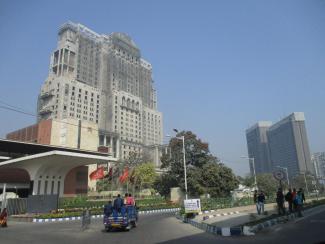Kolkata is making progress, but slower than I had hoped

Kolkata seems to be cleaner and less chaotic than it was in the 1990s. For the example, the public park near the guest house where I used to stay is now being properly maintained. Moreover, there are many more public pay toilets, and they seem to be okay. At the same time, there are now fewer potholes, and many new flyovers. Traffic is moving reasonably well.
There also are many more cars on the streets, however, and if their number increases, the flyovers will become clogged at some point. Kolkata’s growth rates are not as high as those of other Asian megacities, so that point may still be some time off. Slow growth has some advantages.
Garbage collection has improved considerably. What impressed me most, however, was that the people who collect the waste are now much better dressed. They used to look destitute, but now everyone I saw was wearing shoes and shirts. In the early morning, some of the shirts were even ironed. Obviously, they are now better paid.
I was told that they are benefiting from the Mahatma Gandhi National Rural Employment Guarantee. If that is so, they are paid the legal minimum wage, which many informal workers in India are denied. Collecting waste in a megacity is not rural employment in any narrow sense, of course, but many of the persons concerned have moved to the city from rural areas in search of livelihoods.
As a matter of fact, the garbage collectors should be wearing gloves and protective clothing as they do in Hanoi, for example, so there is room for improvement. It is a good sign, however, that Kolkata’s garbage collectors are better off than they were.
The most dramatic change has occurred on the agglomeration’s eastern fringes. In the early 1990s, the Eastern Metropolitan Bypass was built. It made new areas accessible, and urban development followed fast. The few five or six-floor buildings that looked impressive along the Bypass 20 years ago are now dwarfed by high rises with 30 and more floors.
The Bypass was actually relevant in my research. My PhD thesis dealt with cases of public interest litigation, and some of the most important concerned the wetlands east of the city. Non-governmental activists wanted these areas to be protected from urbanisation. They took the state government of West Bengal to court. In the early 1990s, the Calcutta High Court ruled that a huge wetland area of 400 square kilometres or so must not be urbanised, but the judges permitted urban development in other wetland areas. Their stance made sense, they wanted to strike a balance between environmental protection and development.
To tell by the most recent images on Google Earth, the judgment is still being upheld, at least nominally. Friends told me, however, that environmental NGOs have listed some 300 infringements in the area. They are disappointed, or course, but to the foreign sociologist it does look like an achievement that they managed to restrict urbanisation in this area, which is quite close to the city centre. My guess is that the big ponds will not disappear, but that small development projects will slowly penetrate the protected area. All in all, the High Court judgment will probably have a visible impact for more decades to come, but its implementation will become less and less perfect over time. It never was perfect.
When I started my research, my professor told me not to expect much. According to sociological theory back then, the judiciary did not matter much in developing countries. But that was not true in India. The Supreme Court and the High Court have made a difference in many cases. Other High Court rulings have left marks on Kolkata’s development as well. India certainly has two assertive branches of government – the administration and the judiciary, but its legislatures seem subordinate to the respective governments at the national and state levels.
I discussed these issues in my book, which is freely available in an e-book version. I must admit in retrospect that my hopes for change were exaggerated. The basic findings are correct, as far as I can tell, but I had expected more might happen. The judiciary was indeed asserting itself as an independent branch of government, and it did give scope for non-governmental activists to hold state agencies accountable. However, I thought the judges might systematically use their power to improve governance in India. Doing so would have required a coherent strategy, and it now seems to me that such a strategy was never feasible in a country as huge and diverse as India.
All in all, the state of the city seems to have improved. However, some progress that was made in the 1990s has been lost again. I have vivid memories of the police evicting hawkers from the streets and tearing down their stalls in the winter 1996/97. Protests went on for weeks, but afterwards traffic improved considerably. Pedestrians could finally use the sidewalks again and no longer had to compete for road space with buses and cars.
In the meantime, a new state government has taken office, and it is run by a chief minister who supported the hawkers in 1996/97. The hawkers are back – and as there are now more cars on the street, walking around the city is now harder than it was before their eviction 20 years ago.














